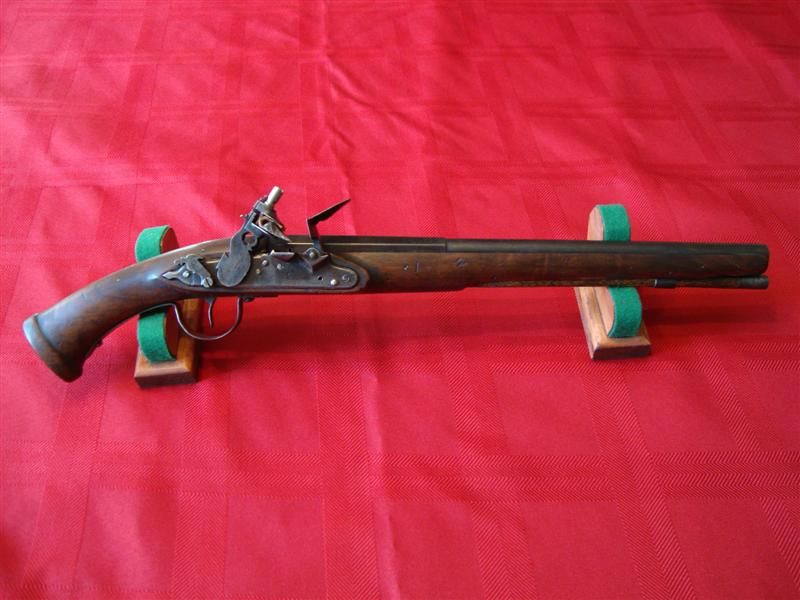MacRob46
45 Cal.
- Joined
- Jun 2, 2007
- Messages
- 643
- Reaction score
- 41
A TALE OF TWO SCOTTISH SNAPHAUNCE
PISTOLS
With Apologies to Forum Member Alden for Appropriating His Style
Way back in 2011, I decided I wanted a Scottish snaphaunce pistol replica of one found in an ancient well in Jamestown, Virginia in 2006. A friend from another forum had found a maker producing one which led me to John Buck of the "Musket Mart" who has been mentioned in the forum from time to time. Mr. Buck was and still is, making a "replica" of said pistol so I contacted him. He said that he was very familiar with the folks at Jamestown who had found the pistol, Preservation Virginia, and that he had been able to get the dimensions of the pistol from them to make his copy. I looked at his web site and saw a pretty clear photo of his version and liked what I saw, for the most part. It had a snaphaunce lock - well it was a snaphaunce which had been modified a bit to turn it into a flintlock. There was no sliding pan cover, protruding sear, etc. but since I already had some rifles with similar locks that was no problem.
I had a hard time getting in touch with Mr. Buck. He did not return e-mail. Finally reached him by phone, found him interesting and we had a long talk about early firearms, etc. He required a 50% deposit of the purchase price which I promptly sent. His ETA for the finished piece was about three months as I recall.
Time passed and no gun. I called and e-mailed, but got no response. Finally reached him at something like five months in and he said he was working on it but had gotten very ill and was having treatments. OK, I understood and he gave me another ETA. More time passed with no gun. Started calling again and finally reached him. Well, times being tough, he had to take a day job. I understood that but was really wanting my gun. Working on it on the weekends and hoped to have it finished in a month or so. Needless to say, I did not receive the gun for about another eight months and believe that I only got it then because I called fairly often for updates. From time of order to receipt was 14 months.
When the gun arrived, I was disappointed. The gun I got generally resembles the sample on his web site but the stock configuration is more like a Spanish Escopeta than a Scottish or English fishtail butt and differs from the web site gun. The battery on the lock is nothing like the battery on the web site gun and is, IMHO, poorly made although it does spark fairly well. I have since learned that the battery on the web site gun is a Rifle Shoppe part. There were file marks everywhere on the gun especially on the reverse of the cock. The belt hook is crude. The octagonal section of the barrel is crudely filed as is the ring just ahead of it. He told me he used L. C. Smith shotgun barrels bought from Numrich Arms and modified but I am not sure of that at all. The bore is about .57 caliber. Overall fit and finish is mediocre at the very best and poor in spots. No real self-respecting Scottish smith would have let a gun out of his shop looking like this one.
What to do? I decided to keep it. Based on the way the transaction occurred, I doubted I would get my money back, at least without waiting for some time. I chalked it up to experience.
Recently I purchased another late 16th c. Scottish pistol from a gun maker friend of mine, Gulielmus Smith, who used to be a member of the forum. I already own four Scottish long guns by him so when he told me about the pistol I immediately purchased it. This is a gun that any Scottish smith would have been proud to offer his customer.
The piece has an ebonized walnut stock, .49 caliber, 11.5 inch barrel made by Gulielmus and an L & R flintlock which has been heavily modified to appear to be a 16th c. snaphaunce lock, down to the sliding pan cover (which does not slide). The lock is made to appear to have been modified to flintlock configuration at some time in the past complete with a plug filling the hole where the sear protruded through the lock plate. The cock and battery are appropriate to the date of the gun as is the shape of the fence on the pan. The delicate finials on the battery spring and the hammer stop are a nice touch as is the engraved comb and filing on the cock itself. Also note the decorative filing on the battery spring. The jaw screw is correct, extending from the lower jaw to the upper, secured by a nut and the shape of the nut is also correct. The battery is nicely filed and can be, if desired, pushed into a horizontal position on the battery spring as these ancient locks allowed and which served as a safety measure. In the case of the Musket Mart pistol, the only way to keep the battery upright is when it is closed on the pan. The trigger is the correct shape and size. The single ramrod thimble is nicely filed and the button on the well-made and sturdy ramrod is nicely turned. The barrel is correctly filed with round bands near the breech and muzzle. The muzzle is slightly flared. There are no file marks anywhere on the metal surfaces. Stock decoration is minimal, as it was on many of these very early Scottish-made guns. The stock architecture follows that of the oldest known pair of fishtail butt pistols which are housed in the Dresden, Germany historical museum. The carefully inlet tang is engraved with a floral design echoing the engraving on the lock plate and lock plate finial.
The overall impression of the GS piece is an historically correct, well-crafted pistol made by a smith who pays great attention to detail as well as being highly skilled in his craft.
The overall impression of the Musket Mart Jamestown pistol is that it was made by someone with an understanding of what the gun should look like but lacking the ability to turn that understanding into reality.
Here is the real issue, at least for me. The GS pistol cost just a few dollars over one-half of the cost of the Jamestown pistol. Of course that is my fault for buying the Musket Mart pistol but at the time GS was not making pistols, just long guns. I also expected more from the Jamestown pistol but got much less. I kept it and have had it for almost three years so it is now a permanent part of my collection, for good or ill, and I post this not to grouse and complain because it is my fault that I own it, but to point out that someone, even someone like me with 46 years of owning and shooting muzzle loaders can make a mistake.
Enjoy the photos of my new gun and feel free to respond sympathetically concerning my earlier purchase.
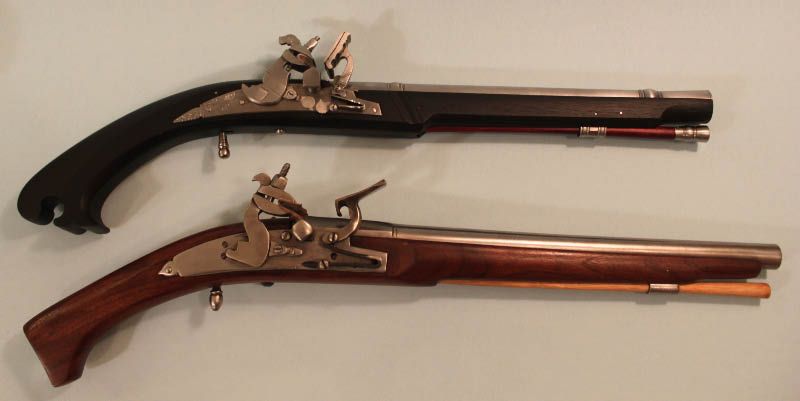
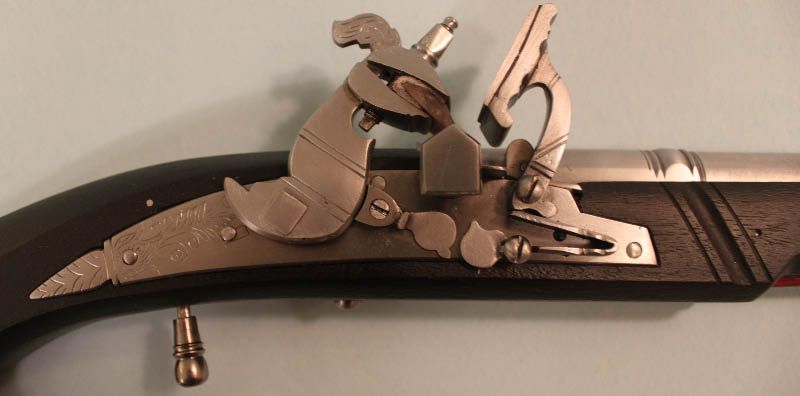
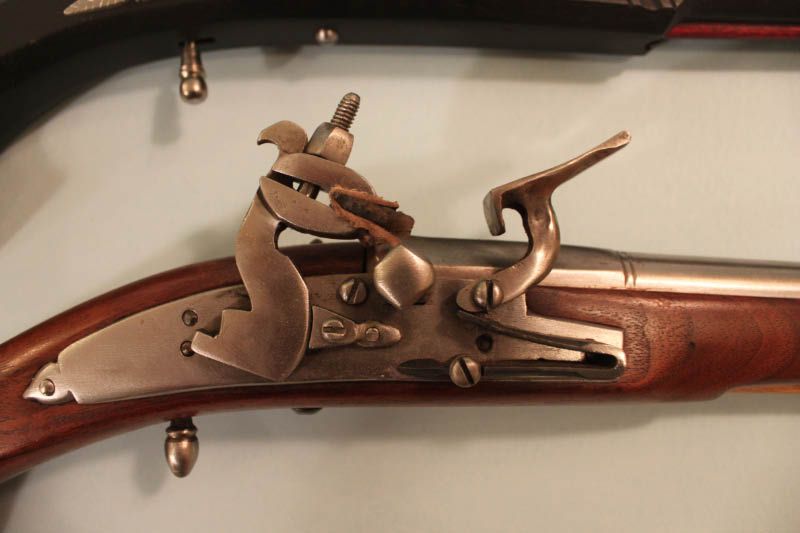
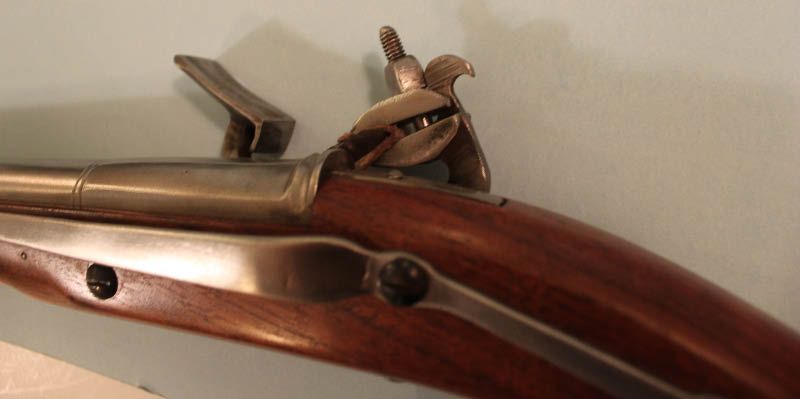
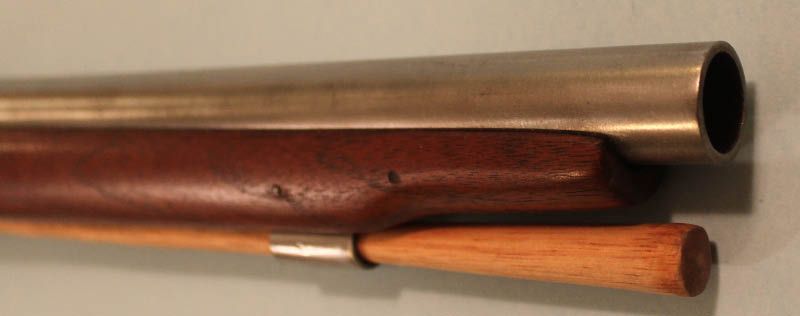
![url]](https://proxy.imagearchive.com/288/288f26b204b1c1c7e6f9da3af8d883ac)
PISTOLS
With Apologies to Forum Member Alden for Appropriating His Style
Way back in 2011, I decided I wanted a Scottish snaphaunce pistol replica of one found in an ancient well in Jamestown, Virginia in 2006. A friend from another forum had found a maker producing one which led me to John Buck of the "Musket Mart" who has been mentioned in the forum from time to time. Mr. Buck was and still is, making a "replica" of said pistol so I contacted him. He said that he was very familiar with the folks at Jamestown who had found the pistol, Preservation Virginia, and that he had been able to get the dimensions of the pistol from them to make his copy. I looked at his web site and saw a pretty clear photo of his version and liked what I saw, for the most part. It had a snaphaunce lock - well it was a snaphaunce which had been modified a bit to turn it into a flintlock. There was no sliding pan cover, protruding sear, etc. but since I already had some rifles with similar locks that was no problem.
I had a hard time getting in touch with Mr. Buck. He did not return e-mail. Finally reached him by phone, found him interesting and we had a long talk about early firearms, etc. He required a 50% deposit of the purchase price which I promptly sent. His ETA for the finished piece was about three months as I recall.
Time passed and no gun. I called and e-mailed, but got no response. Finally reached him at something like five months in and he said he was working on it but had gotten very ill and was having treatments. OK, I understood and he gave me another ETA. More time passed with no gun. Started calling again and finally reached him. Well, times being tough, he had to take a day job. I understood that but was really wanting my gun. Working on it on the weekends and hoped to have it finished in a month or so. Needless to say, I did not receive the gun for about another eight months and believe that I only got it then because I called fairly often for updates. From time of order to receipt was 14 months.
When the gun arrived, I was disappointed. The gun I got generally resembles the sample on his web site but the stock configuration is more like a Spanish Escopeta than a Scottish or English fishtail butt and differs from the web site gun. The battery on the lock is nothing like the battery on the web site gun and is, IMHO, poorly made although it does spark fairly well. I have since learned that the battery on the web site gun is a Rifle Shoppe part. There were file marks everywhere on the gun especially on the reverse of the cock. The belt hook is crude. The octagonal section of the barrel is crudely filed as is the ring just ahead of it. He told me he used L. C. Smith shotgun barrels bought from Numrich Arms and modified but I am not sure of that at all. The bore is about .57 caliber. Overall fit and finish is mediocre at the very best and poor in spots. No real self-respecting Scottish smith would have let a gun out of his shop looking like this one.
What to do? I decided to keep it. Based on the way the transaction occurred, I doubted I would get my money back, at least without waiting for some time. I chalked it up to experience.
Recently I purchased another late 16th c. Scottish pistol from a gun maker friend of mine, Gulielmus Smith, who used to be a member of the forum. I already own four Scottish long guns by him so when he told me about the pistol I immediately purchased it. This is a gun that any Scottish smith would have been proud to offer his customer.
The piece has an ebonized walnut stock, .49 caliber, 11.5 inch barrel made by Gulielmus and an L & R flintlock which has been heavily modified to appear to be a 16th c. snaphaunce lock, down to the sliding pan cover (which does not slide). The lock is made to appear to have been modified to flintlock configuration at some time in the past complete with a plug filling the hole where the sear protruded through the lock plate. The cock and battery are appropriate to the date of the gun as is the shape of the fence on the pan. The delicate finials on the battery spring and the hammer stop are a nice touch as is the engraved comb and filing on the cock itself. Also note the decorative filing on the battery spring. The jaw screw is correct, extending from the lower jaw to the upper, secured by a nut and the shape of the nut is also correct. The battery is nicely filed and can be, if desired, pushed into a horizontal position on the battery spring as these ancient locks allowed and which served as a safety measure. In the case of the Musket Mart pistol, the only way to keep the battery upright is when it is closed on the pan. The trigger is the correct shape and size. The single ramrod thimble is nicely filed and the button on the well-made and sturdy ramrod is nicely turned. The barrel is correctly filed with round bands near the breech and muzzle. The muzzle is slightly flared. There are no file marks anywhere on the metal surfaces. Stock decoration is minimal, as it was on many of these very early Scottish-made guns. The stock architecture follows that of the oldest known pair of fishtail butt pistols which are housed in the Dresden, Germany historical museum. The carefully inlet tang is engraved with a floral design echoing the engraving on the lock plate and lock plate finial.
The overall impression of the GS piece is an historically correct, well-crafted pistol made by a smith who pays great attention to detail as well as being highly skilled in his craft.
The overall impression of the Musket Mart Jamestown pistol is that it was made by someone with an understanding of what the gun should look like but lacking the ability to turn that understanding into reality.
Here is the real issue, at least for me. The GS pistol cost just a few dollars over one-half of the cost of the Jamestown pistol. Of course that is my fault for buying the Musket Mart pistol but at the time GS was not making pistols, just long guns. I also expected more from the Jamestown pistol but got much less. I kept it and have had it for almost three years so it is now a permanent part of my collection, for good or ill, and I post this not to grouse and complain because it is my fault that I own it, but to point out that someone, even someone like me with 46 years of owning and shooting muzzle loaders can make a mistake.
Enjoy the photos of my new gun and feel free to respond sympathetically concerning my earlier purchase.





Last edited by a moderator:




